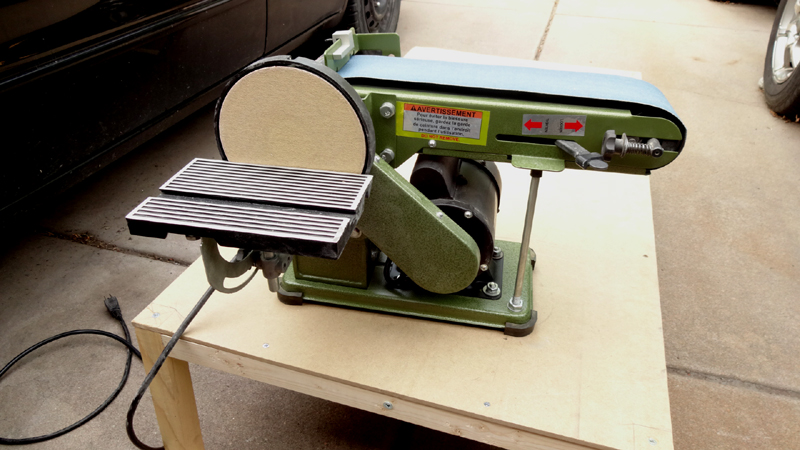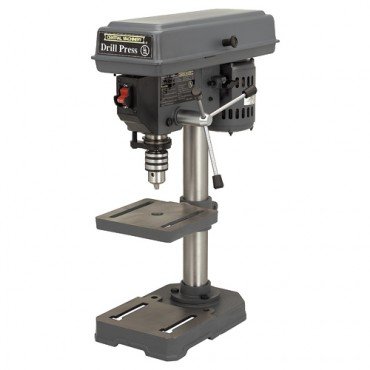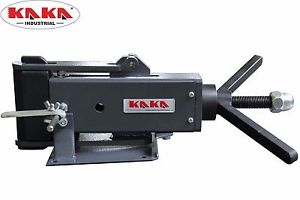Harbor Freight and home improvement stores. I think this is a Sears branded unit I found on Craig's List, I paid $75. A new one runs around a hundred bucks.
TOOLS
Other than the ususal assortment of hand tools found in most homes, I had to get a few more tools that were specific to this project. It's difficult to include these in the project budget, as I will be using them again for future projects. But the bottom line is that these tool purchased were money out the door.
BAND SAW
|
|
|
| Inexpensive bandsaws
are available at stores like Harbor Freight and home improvement stores. I think this is a Sears branded unit I found on Craig's List, I paid $75. A new one runs around a hundred bucks. |
Cutting the 1/4" aluminum plate requires a different blade than the wood cutting blade that came with the saw. I had trouble tracking one down locally, so I ordered a blade from Amazon, cost $12.17 with free Prime shipping. This is a Vermont American #31152 3/8" x 59-1/2" 18 TPI General Purpose metal blade. |
|
|
|
The work table of the bandsaw was too small to accomodate the larger pieces of aluminum plate, so I constructed a 2' x 4' table extension from 1/4" thick particle board and 2"x2" pine studs. Total cost under $10.
|
|
|
|
Here's what it't like trying to make a cut with the stock work table |
The table extension makes the job much easier. The extension is secured to the stock table with C-clamps. |
BENCH SANDER

A Harbor Freight special. A combination belt and disc sander, this tool is essential for smoothing out the rough edges of the aluminum plate parts. Inexpensive models available for around a hundred dollars. I was fortunate enough to get one on loan from my son-in-law.
Here's two cut parts, before and after sanding the edges and rounding the corners.
Be sure to replace the woodworking belt in the bench sander with a metal grade belt. About ten dollar for a package of two belts.
DRILL PRESS

Another Harbor Freight acquisition, the little drill press costs around $70, plus I spent another $25 on drill bits. An essential tool for drilling straight accurate holes.
METAL BENDER

Here's where I started running into problems. The project design requires several 90 degree bends in the 1/4" thick aluminum plate. Inexpensive benchtop brakes are available, but they do not have the capacity to bend aluminum of this thickness. I found a bender online for about a hundred dollars from Churchill Tools, identical to the one depicted above except for brand markings. The specifications said it would bend 1/4" aluminum up to 4 inches wide. I adjusted the plans to meet the capacity of the tool.
Churchill had the tool on back order for two months and I was getting impatient to get going. I had most of my parts cut, sanded and drilled. All I needed to move forward was to make the required bends. I found an identical bender online from Kaka Industries. Identical except for the price, it was about forty dollars more expensive. Either way I had to spend an additional twenty dollars for shipping. Another $160 into the project.
This is not a power tool. It is not a hydraulic or pneumatic too. The power to bend 1/4" thick metal is applied by manpower using the mechanical advantage of those big wing-nut looking handles and a screw driven die. I'm a big truck drivin' man, and it took almost all of my strength to get the bend started.
Once I had the bender set up, I resumed the project. The bender did the job, but not very well. The bends aren't quite square and the pre-drilled bracket holes didn't quite line up. I ended up redoing several parts and I'm still not satisfied with the result. I'm uncertain as to whether I got a defective bender with an inaccurate die, or whether it tolerance of the machines design isn't up to my requirements. The whole project is once again on hold while I decide how to proceed. I need to either find a different tool or outsource the bending to a local machine shop.
POSTSCRIPT: I eventully abandoned the metal bender for fabricating the upright braces. I found that I could accomplish far better results using extruded L-beams and a handful of hardware.